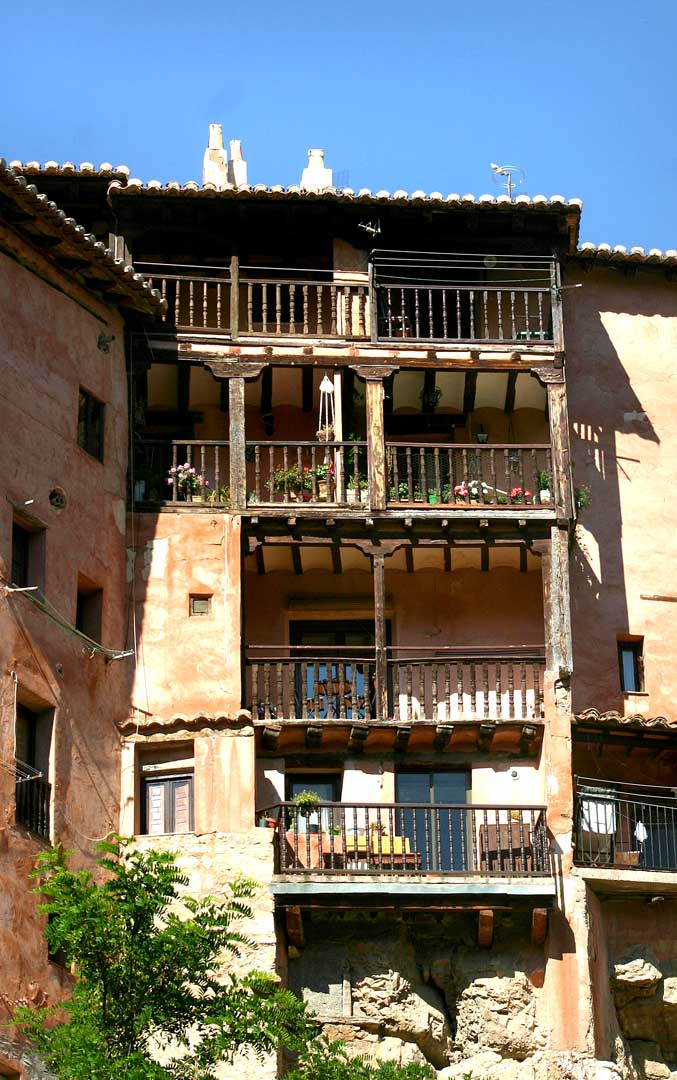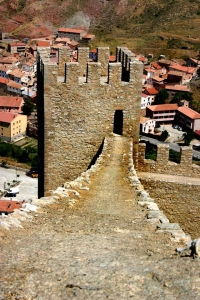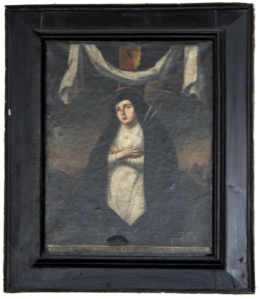Standing in the car-park below Albarracin, staring upward, wondering how the wooden balconies above you haven’t succumbed to the force of gravity after three hundred years, you are offered three choices; steep – a slope that rises up and provides access for residents and their cars, but the long way round; very steep – a stepped slope, one-third the length of the lower one but definitely puff-making; and ‘I’m not sure I can manage those’ – a flight of steps that require a lot of knee-lifting but get you into the heart of things pretty quickly.
 The heat of the day hadn’t arrived and I’d had my booster shot of caffeine from the café in the car park, so I took the Himalayan route, unaided by either a hand rail to pull me up the near vertical steps or Sherpa Tenzing to help with my bag. From below, everything looks easily identifiable, so that you can move between castle, cathedral and quaint alleyways with ease, but the moment you step into the shadowed, red-stone gullies, whose walls and windows seem to curl inward over your head, their eaves almost touching, you are lost to the idea of urban planning as you know it and have to guide yourself by instinct – usually wrong – or give yourself up to happenchance. The latter is usually the better option, given that the town is so small that if you get lost, just keep heading down and you will eventually arrive back at the car park.
The heat of the day hadn’t arrived and I’d had my booster shot of caffeine from the café in the car park, so I took the Himalayan route, unaided by either a hand rail to pull me up the near vertical steps or Sherpa Tenzing to help with my bag. From below, everything looks easily identifiable, so that you can move between castle, cathedral and quaint alleyways with ease, but the moment you step into the shadowed, red-stone gullies, whose walls and windows seem to curl inward over your head, their eaves almost touching, you are lost to the idea of urban planning as you know it and have to guide yourself by instinct – usually wrong – or give yourself up to happenchance. The latter is usually the better option, given that the town is so small that if you get lost, just keep heading down and you will eventually arrive back at the car park.
Nothing prepares you for Albarracin, with its narrow streets terracing up the hillside and the casas colgadas, houses with wooden balconies precariously hanging over the streets below.
Officially designated a ‘city’, Albarracin it is little more than a large village, although as there is no Spanish equivalent for the English word ‘town’, only ‘pueblo’ or ‘ciudad’, it probably helps that the ‘big village’ has a Cathedral to raise it to a higher status.
 Officially you will be told that the two focal points of Spanish life are the state and the church, so in many Spanish villages you will find that the church and town hall are close to each other. However, the Spanish themselves will tell you that the real hubs of Spanish living are the siesta and the fiesta.
Officially you will be told that the two focal points of Spanish life are the state and the church, so in many Spanish villages you will find that the church and town hall are close to each other. However, the Spanish themselves will tell you that the real hubs of Spanish living are the siesta and the fiesta.
 Stand in the centre of the Plaza Mayor, and in a 360-degree turn you’ll see a town square almost as it would have looked in the 16th and 17th centuries — but without the cars and café chairs, of course. The buildings have been tidied up but not tarted up and the streets that radiate off at odd angles are like cobbled, stone-and-iron canyons; up steps, around sharp bends, down tiny alleyways, where even in the height of summer only shadows dwell.
Stand in the centre of the Plaza Mayor, and in a 360-degree turn you’ll see a town square almost as it would have looked in the 16th and 17th centuries — but without the cars and café chairs, of course. The buildings have been tidied up but not tarted up and the streets that radiate off at odd angles are like cobbled, stone-and-iron canyons; up steps, around sharp bends, down tiny alleyways, where even in the height of summer only shadows dwell.
The Plaza is dominated by the Ayuntamiento, the Town Hall, which forms a U. The square has its origins in the 13th century, when it was built on the foundations of the ancient wall, but the more ‘modern’ building of the Town Hall is the result of a total renovation in the 16th century, built in the typical Arogonése style of architecture of the period, with its colonnaded lower level providing shade during the heat of the summer months and the snows of winter. To the side, a mirador looks down over the village and the Riu Guadalaviar. A black and white photo of the Plaza Mayor, taken during the 1950’s, shows that nothing has changed structurally in the intervening half-century, probably due more to the economic decline the town went into after the War of Independence with France in the early 1800s until the ‘deliverance’ of tourism during the last decade than any premeditated conservation on the part of the town council.
For centuries, the Plaza Mayor was the end, or perhaps the beginning, depending in which direction you were headed, of the road to Molina de Aragon, hence the name of the tiny street, barely a couple of metres wide in some places, that heads off into the shadows opposite the Town Hall, Calle Portal de Molino. It’s difficult to imagine flocks of sheep and cattle being driven down it to market in the town square during Albarracin’s heyday, when cattle and wool exports during the 18th century paid for the magnificent big rambling casas señoriales, noblemen’s homes, that date from this period.

 Walking up the narrow street, I feel warmth exude from the ancient walls, not only from the heat of the sun the stone has absorbed, but from the dusky pink hue of some of the buildings. This is because of the locally produced plaster, which contains tiny flecks of iron, which rusts when it rains and gives the walls their unique colour.
Walking up the narrow street, I feel warmth exude from the ancient walls, not only from the heat of the sun the stone has absorbed, but from the dusky pink hue of some of the buildings. This is because of the locally produced plaster, which contains tiny flecks of iron, which rusts when it rains and gives the walls their unique colour.
Half-way up Calle Portal, it opens out into a small square, the Plaza de la Comindad, where the Casa de la Comunidad stands. Up until the 19th century, representatives of the twenty two villages and towns of Albarracín would meet here. Far more delightful, though, is the upper area of the Plaza, known as the Rincón de Abanico, Fan Corner, because the interconnecting houses spread out, imitating the shape of a fan. At the end of the street, where one of the original entrances to the town, the Portal de Molino, still stands, I turn around to look at probably the most emblematic building of  Albarracin, la Casa de Julianetta, a tiny higgledy-piggledy house, built into the Y of Calle Portal de Molino and Calle Santiago, where there’s barely a straight line or sure angle. Other than that it was the home of Julianeta,“una señora del pueblo que tenía una casa muy humilde, modesta, muy propia de Albarracín”, a lady of the village who’s house was very humble, modest, and typical of Abarracín, there is no historic or cultural reference, but it is a wonderful bit of ‘eye candy’ for lovers of Medieval architecture.
Albarracin, la Casa de Julianetta, a tiny higgledy-piggledy house, built into the Y of Calle Portal de Molino and Calle Santiago, where there’s barely a straight line or sure angle. Other than that it was the home of Julianeta,“una señora del pueblo que tenía una casa muy humilde, modesta, muy propia de Albarracín”, a lady of the village who’s house was very humble, modest, and typical of Abarracín, there is no historic or cultural reference, but it is a wonderful bit of ‘eye candy’ for lovers of Medieval architecture.
It seems strange to me that something smaller than many village churches I’ve seen in Spain should be exalted with the name ‘Cathedral’, but Alabrracin definitely has one, dating from the 16th century. On closer inspection, it doesn’t live up to it’s grandiose title either, it’s most delightful artwork being the stunningly carved wooden alterpiece of San Pedro, removed from the Iglesia de Santa María, on the edge of the city, when it was deconsecrated and became an auditorium. At various times the cathedral plunges into semi-darkness and the assembled visitors wait for someone to drop a one euro coin into the slot to switch on the spot lights, strategically placed in the side chapels and around the 17th-century High Altar. I once spent €10 this way trying to photograph the glorious Luis XV-inspired ballroom of the Casino in Murcia, giving everyone a free show while getting in my way, so I declined to do so again. I followed the crowd of misers as we left the building in darkness and empty of redemptive souls.
 One thing that did strike me about the Cathedral was that it has the only calvario I’ve ever seen inside a building. The calvario, the stations of the cross, are usually found, at least in Spain, forming a ziggurat footpath up a hill crowned by an hermita, with each of the fourteen stages marked by ceramic images in small niches. Here, they are illustrated by ancient oil paintings, cracked and faded with years of exposure, interspersed with seven images of Mary in the simple garb of a nun, each with an extra sword plunged into her breast, representing the Seven Sorrows, one for each of seven sorrowful episodes that occurred during her life.
One thing that did strike me about the Cathedral was that it has the only calvario I’ve ever seen inside a building. The calvario, the stations of the cross, are usually found, at least in Spain, forming a ziggurat footpath up a hill crowned by an hermita, with each of the fourteen stages marked by ceramic images in small niches. Here, they are illustrated by ancient oil paintings, cracked and faded with years of exposure, interspersed with seven images of Mary in the simple garb of a nun, each with an extra sword plunged into her breast, representing the Seven Sorrows, one for each of seven sorrowful episodes that occurred during her life.
As no trip to Paris can be seen as complete without a ride to the top of the Eiffel Tower, a climb up to the walls of Albarracin is also an itineristic necessity, (although having lived in the French Capital during my thirties and not having entered the Tower’s lift, I could possible have passed on the Albarracin excursion).
The castle stands on a rise behind the Cathedral, but the long crescent of the extant wall radiates from both sides of a tower, curving like protective arms. Which is exactly what they were intended to be. Whereas most walled cities used the walls to protect only the citizens and therefore concentrated on the urban structure, those of Albarracin where designed to safeguard livestock during times of siege and to provide ample grazing land.
Climbing up to the castle may not have seemed the most sensible thing to do on a steaming July day after a heavy lunch of excellent local chulletas ternasco, a specially bred lamb unique to Aragon, that even has its of Denominación de Origen. Either a way to walk off lunch or bring on a coronary, depending on how you look at it, but it needs to be done at sometime for the stunning views.
 The apparently steep incline isn’t as difficult as it looks, as the path meanders up quite languidly, (unless you want to use the path at the side of the wall which could probably benefit by having a Stannah Stair Lift installed), and is almost a nature ramble – bees gather pollen, dragones, dusky greyish-green lizards, skitter across the stony path, and black-winged butterflies take short bursts of erratic flight in their short, day-long lives.
The apparently steep incline isn’t as difficult as it looks, as the path meanders up quite languidly, (unless you want to use the path at the side of the wall which could probably benefit by having a Stannah Stair Lift installed), and is almost a nature ramble – bees gather pollen, dragones, dusky greyish-green lizards, skitter across the stony path, and black-winged butterflies take short bursts of erratic flight in their short, day-long lives.
The first stop-off point is a short flight of steps up to the top of the right wing of the wall. As you take the last step onto a small landing, the wall offsets to the left – and vertigo kicks in! What appears to be a wall of modest height from below suddenly assumes frightening proportions from this angle. No handrail, no crenulations, no waist-high wall to stop the cumbersome of foot from tumbling earthward. Nothing! – just a rough-topped wall that swoops down to a corner tower before doing a sharp right to continue on its way, the fall of the land dropping to the river valley below. I would not have like to have been a guard on patrol at night in the depths of an icy winter, and these days to walk it is suitable only for those who find the white knuckle rides at Blackpool Pleasure Beach just a bit of a jolly.
Vertigo and I are old companions so, having gingerly lain down to take a photo, I equally gingerly slithered back down the stairs, to take the final climb up to the Torre Andador, the Walker’s Tower, presumably named for those poor souls who had to patrol the nerve-wracking perimeter. It was worth the climb. Ahead of me I looked down over Albarracin – its spaghetti alleyways, church towers and mottled crunched-up rooftops – over to the backdrop of the Sierra de Albarracin, where roam the herds that provide the village’s famous queso puro de oveja, pure sheep’s cheese. My eye followed the meandering River Guadalaviar, one of the richest trout rivers in Spain, and where the annual national trout fishing competition is held, past the circular turret at the end of the wall, and on through the orchards and cornfields, pockmarked with houses and small factories, as it wandered its way onward to Teruel and beyond.
This article is an extended version of the information in ‘Disney’s Mountain-Top Village’, one of twenty-two excursions throughout the Valencian Community and Teruel, taken from Inland Trips From the Costa Blanca
Please visit my web site, Spain Uncovered, and blog Valpaparazzi for random notes about life in Spain a few years ago.



Leave A Comment